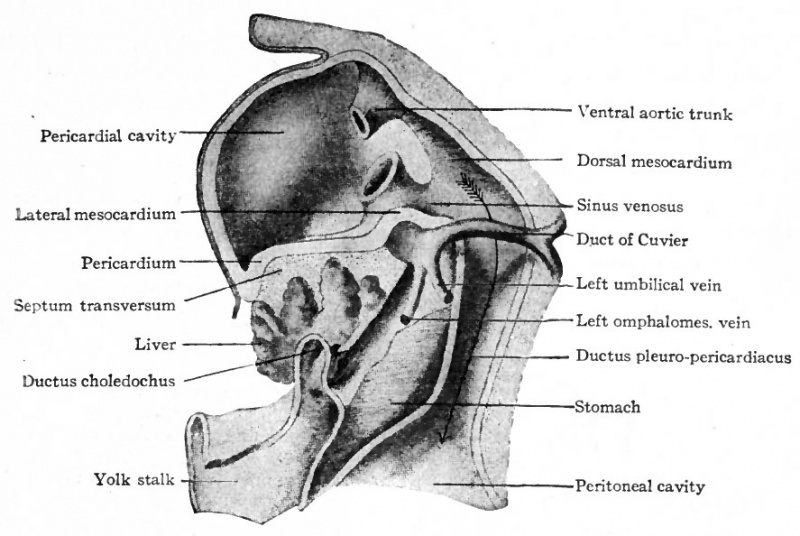File:Bailey292.jpg

Original file (887 × 594 pixels, file size: 94 KB, MIME type: image/jpeg)
Fig. 292. From a model of the septum transversum and liver of a human embryo of 3 mm
His, Kollmann.
The communication between the pericardial cavity and the rest of the embryonic ccelom is soon partly cut off by the development of a transverse fold - the septum transversum. This septum is formed in close relation with the omphalomesenteric veins. These vessels unite in the sinus venosus at the caudal end of the heart, whence they diverge in the splanchnic mesoderm. They are thus embedded in the mesodermal layer of the splanchnopleure, and as the latter closes in from either side to form the gut, the vessels form ridge-like projections into the ccelom. As the vessels increase in size, the ridges become so large that the splanchnic mesoderm is pushed outward against the parietal mesoderm and fuses with it (Fig. 291). Thus a partition is formed on each side, which is attached on the one hand to the mesentery and on the other hand to the ventral and lateral body walls, and which contains the omphalomesenteric veins. It is obvious that these partitions, forming the septum transversum, close the ventral part of the communication between the pericardial cavity and the rest of the ccelom. The dorsal part of the communication remains open on each side of the mesentery as the ductus pleuro-pericardiacus (dorsal parietal recess of His) (Figs. Fig. 291 and Fig. 292).
As the heart develops it migrates caudally, and by corresponding migration the pericardial cavity draws the ventral edge of the septum transversum farther caudally, so that the cephalic surface of the latter faces ventrally and cranially.
In other words the septum comes to lie in an oblique cranio-caudal plane. The pericardial cavity therefore comes to lie ventral to the ductus pleuro-pericardiaci. The latter one on each side of the mesentery are two passages which communicate on the one hand with the pericardial cavity and on the other hand with the peritoneal cavity, while they themselves form the cavities into which the lungs grow the pleural cavities. (Compare Figs. Fig. 292, Fig. 293 and Fig. 294.)
- Text-Book of Embryology: Germ cells | Maturation | Fertilization | Amphioxus | Frog | Chick | Mammalian | External body form | Connective tissues and skeletal | Vascular | Muscular | Alimentary tube and organs | Respiratory | Coelom, Diaphragm and Mesenteries | Urogenital | Integumentary | Nervous System | Special Sense | Foetal Membranes | Teratogenesis | Gallery of All Figures
| Historic Disclaimer - information about historic embryology pages |
|---|
| Pages where the terms "Historic" (textbooks, papers, people, recommendations) appear on this site, and sections within pages where this disclaimer appears, indicate that the content and scientific understanding are specific to the time of publication. This means that while some scientific descriptions are still accurate, the terminology and interpretation of the developmental mechanisms reflect the understanding at the time of original publication and those of the preceding periods, these terms, interpretations and recommendations may not reflect our current scientific understanding. (More? Embryology History | Historic Embryology Papers) |
Reference
Bailey FR. and Miller AM. Text-Book of Embryology (1921) New York: William Wood and Co.
Cite this page: Hill, M.A. (2024, April 25) Embryology Bailey292.jpg. Retrieved from https://embryology.med.unsw.edu.au/embryology/index.php/File:Bailey292.jpg
- © Dr Mark Hill 2024, UNSW Embryology ISBN: 978 0 7334 2609 4 - UNSW CRICOS Provider Code No. 00098G
File history
Click on a date/time to view the file as it appeared at that time.
| Date/Time | Thumbnail | Dimensions | User | Comment | |
|---|---|---|---|---|---|
| current | 22:13, 23 January 2011 |  | 887 × 594 (94 KB) | S8600021 (talk | contribs) | {{Template:Bailey 1921 Figures}} Category:Human Category:Coelom |
You cannot overwrite this file.
File usage
The following 2 pages use this file:
